外研版初中英语知识点总结
- 格式:doc
- 大小:491.50 KB
- 文档页数:79
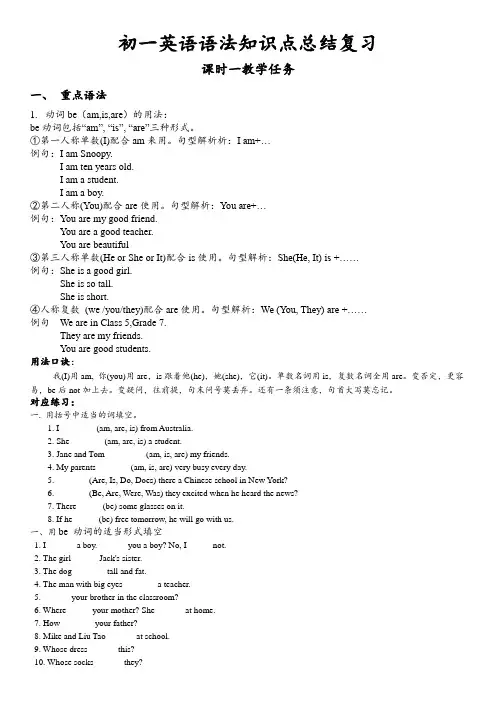
初一英语语法知识点总结复习课时一教学任务一、重点语法1.动词be(am,is,are)的用法:be动词包括“am”, “is”, “are”三种形式。
①第一人称单数(I)配合am来用。
句型解析析:I am+…例句:I am Snoopy.I am ten years old.I am a student.I am a boy.②第二人称(You)配合are使用。
句型解析:You are+…例句:You are my good friend.You are a good teacher.You are beautiful③第三人称单数(He or She or It)配合is使用。
句型解析:She(He, It) is +……例句:She is a good girl.She is so tall.She is short.④人称复数(we /you/they)配合are使用。
句型解析:We (You, They) are +……例句We are in Class 5,Grade 7.They are my friends.You are good students.用法口诀:我(I)用am, 你(you)用are,is跟着他(he),她(she),它(it)。
单数名词用is,复数名词全用are。
变否定,更容易,be后not加上去。
变疑问,往前提,句末问号莫丢弃。
还有一条须注意,句首大写莫忘记。
对应练习:一. 用括号中适当的词填空。
1. I ________(am, are, is) from Australia.2. She _______ (am, are, is) a student.3. Jane and Tom _________(am, is, are) my friends.4. My parents _______ (am, is, are) very busy every day.5. _______ (Are, Is, Do, Does) there a Chinese school in New York?6. _______ (Be, Are, Were, Was) they excited when he heard the news?7. There _____ (be) some glasses on it.8. If he _____ (be) free tomorrow, he will go with us.一、用be 动词的适当形式填空1. I ______ a boy. ______ you a boy? No, I _____ not.2. The girl______ Jack's sister.3. The dog _______ tall and fat.4. The man with big eyes _______ a teacher.5. ______ your brother in the classroom?6. Where _____ your mother? She ______ at home.7. How _______ your father?8. Mike and Liu Tao ______ at school.9. Whose dress ______ this?10. Whose socks ______ they?11. That ______ my red skirt.12. Who ______ I?13.The jeans ______ on the desk.14.Here ______ a scarf for you.15. Here ______ some sweaters for you.16. The black gloves ______ for Su Yang.17. This pair of gloves ______ for Yang Ling.18. The two cups of milk _____ for me.19. Some tea ______ in the glass.20. Gao shan's shirt _______ over there.第二课时(1)英语人称代词和物主代词一、人称代词表示“我”、“你”、“他”、“她”、“它”、“我们”、“你们”、“他们”的词,叫做人称代词。
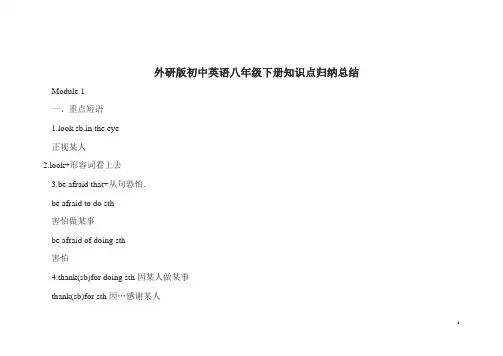
外研版初中英语八年级下册知识点归纳总结Module 1
一、重点短语
1.look sb.in the eye
正视某人
2.look+形容词看上去
3.be afraid that+从句恐怕.
be afraid to do sth
害怕做某事
be afraid of doing sth
害怕
4.thank(sb)for doing sth因某人做某事
thank(sb)for sth因…感谢某人
5.can't wait to do sth迫不及待做某事
6.spend时间/金钱+(in)doing sth.某
人花时间/金钱做
spend时间/金钱+on sth.某人在某方面花时间/金钱
7.be proud of.…以…为自豪
8.be proud to do sth.为做某事而感到自豪
9.be proud that.为.感到自豪
10.hear from/receive a letter from…收
到灬的来信
11.each other互相,彼此
12.arrive in/at到达
13.be good at擅长,善于
14.have a try
尝试
15.on top在上面,处于优势
16.in the middle在中间
17.as well也;还
18.in the right way以正确的方式
19.be excited about
对灬兴奋。

外研版初中英语各册知识点
外研版初中英语教材由六个册别组成,分别是六年级上册到六年级下册,七年级上册到七年级下册,和八年级上册到八年级下册。
每个册别都
包含了以下几个部分:单词、语法、听力和口语、阅读、写作、任务与项目、文化背景知识和考试技巧。
下面将分别介绍每个部分的主要内容。
1.单词:每个册别的单词部分都包含了新单词的拼写和发音,单词的
词性和词义。
教材通过图片、例句和语境等方式来帮助学生掌握单词的用法。
2.语法:语法部分主要介绍了不同时态的用法和句型结构等。
教材通
过实例和练习来帮助学生理解和掌握语法知识。
3.听力和口语:听力和口语部分主要训练学生的听力理解和口语表达
能力。
教材提供了各种听力材料和口语活动,通过模仿和实践来提高学生
的听说能力。
5.写作:写作部分主要训练学生的写作能力。
教材提供了各种写作任务,如写日记、写信、写作文等,通过指导和练习来提高学生的写作水平。
6.任务与项目:任务与项目部分主要是为了培养学生的综合运用能力。
教材通过各种任务和项目来促使学生运用所学知识进行实际操作,培养学
生的综合能力和创造力。
7.文化背景知识:教材还提供了一些与文化背景相关的知识。
通过介
绍不同国家和文化的特点,帮助学生了解和理解不同文化之间的差异。
8.考试技巧:教材还提供了一些应试技巧和策略,帮助学生更好地应
对考试,提高考试成绩。
综上所述,外研版初中英语教材通过单词、语法、听力和口语、阅读、写作、任务与项目、文化背景知识和考试技巧等方面的综合训练,全面提
高学生的英语综合能力。

最新外研版英语八年级上册知识点总结
(精华版)
1. 语法知识点
- 时态:包括一般现在时、一般过去时、一般将来时等;
- 基本句型:包括陈述句、疑问句、否定句等;
- 名词:包括可数名词、不可数名词、复数形式等;
- 代词:包括人称代词、物主代词、反身代词等;
- 形容词:包括形容词的比较级和最高级等;
- 副词:包括副词的用法和位置等;
- 连词:包括并列连词、选择连词、从属连词等;
- 介词:包括基本介词和常用介词短语等;
- 动词:包括动词的不同形式、时态和语态等;
- 句子结构:包括主谓结构、主语从句、宾语从句等;
- 非谓语动词:包括动词不定式、动名词和分词等;
2. 词汇知识点
- 单词拼写:包括常见的单词拼写错误;
- 同义词:包括一些常见的同义词辨析;
- 常用短语:包括日常交际中常用的短语;
- 常用惯用语:包括一些惯用语的正确使用;
3. 阅读技巧
- 阅读理解:包括快速阅读和细节理解;
- 阅读速度:包括提高阅读速度和理解能力的方法;
- 阅读技巧:包括推测词义、寻找关键词等技巧;
4. 写作技巧
- 书信写作:包括格式、语言表达和常用句型等;
- 日记写作:包括表达个人感受和经历的方法;
- 作文写作:包括如何组织思路和提高写作水平的方法;
以上是最新外研版英语八年级上册的知识点总结,希望对你的研究有所帮助。
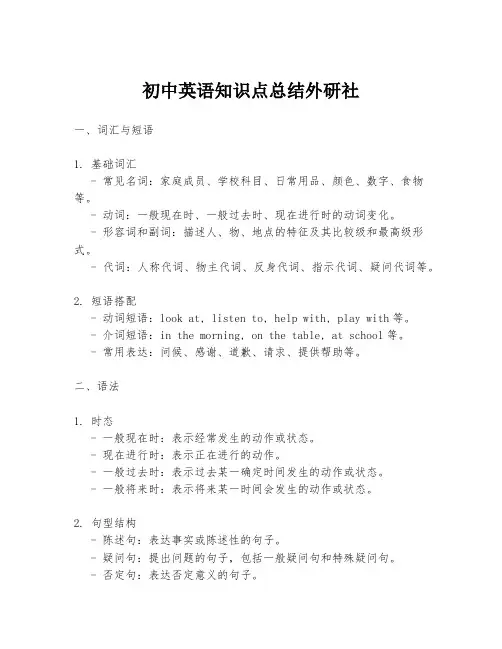
初中英语知识点总结外研社一、词汇与短语1. 基础词汇- 常见名词:家庭成员、学校科目、日常用品、颜色、数字、食物等。
- 动词:一般现在时、一般过去时、现在进行时的动词变化。
- 形容词和副词:描述人、物、地点的特征及其比较级和最高级形式。
- 代词:人称代词、物主代词、反身代词、指示代词、疑问代词等。
2. 短语搭配- 动词短语:look at, listen to, help with, play with等。
- 介词短语:in the morning, on the table, at school等。
- 常用表达:问候、感谢、道歉、请求、提供帮助等。
二、语法1. 时态- 一般现在时:表示经常发生的动作或状态。
- 现在进行时:表示正在进行的动作。
- 一般过去时:表示过去某一确定时间发生的动作或状态。
- 一般将来时:表示将来某一时间会发生的动作或状态。
2. 句型结构- 陈述句:表达事实或陈述性的句子。
- 疑问句:提出问题的句子,包括一般疑问句和特殊疑问句。
- 否定句:表达否定意义的句子。
- 祈使句:表示命令、请求或建议的句子。
3. 语态- 被动语态:表示句子的主语是动作的承受者。
4. 非谓语动词- 动名词:作为名词使用,可以作主语、宾语等。
- 分词:现在分词和过去分词,用作形容词或副词。
5. 从句- 宾语从句:作为句子宾语的从句。
- 定语从句:修饰名词或代词的从句,通常由关系代词引导。
- 状语从句:表示时间、原因、条件、结果等的从句。
三、阅读理解1. 阅读技巧- 快速阅读:通过略读抓住文章大意。
- 精读:仔细阅读,理解文章细节和深层含义。
- 寻找主题句:通常位于段落的开头,概括段落主要内容。
2. 阅读题型- 事实细节题:根据文章内容选择或判断正确的信息。
- 主旨大意题:确定文章或段落的中心思想。
- 推理判断题:根据文章内容进行逻辑推理,得出结论。
四、写作技巧1. 文章结构- 引言:介绍背景信息,引出文章主题。

外研社版九年级英语知识点一、动词时态动词时态主要分为以下几种:一般现在时、一般过去时、一般将来时、现在进行时、过去进行时、将来进行时、现在完成时、过去完成时、将来完成时。
1. 一般现在时(Simple Present Tense)表示经常性或习惯性的动作,或者客观真理等。
句子结构为:主语 + V原 + 其他成分。
如:- I go to school every day.- Water boils at 100 degrees Celsius.2. 一般过去时(Simple Past Tense)表示过去发生的动作或状态,并且已经结束。
句子结构为:主语 + V过去式 + 其他成分。
如:- She visited her grandparents last weekend.- They played basketball yesterday.3. 一般将来时(Simple Future Tense)表示将来要发生的动作或状态。
句子结构为:主语 + will + V 原 + 其他成分。
如:- I will buy a new car next year.- They will have a party on Friday.4. 现在进行时(Present Continuous Tense)表示现在正在进行的动作,常与时间状语连用。
句子结构为:主语 + am/is/are + V-ing + 其他成分。
如:- She is reading a book now.- They are playing soccer in the park.5. 过去进行时(Past Continuous Tense)表示过去某一时刻正在进行的动作。
句子结构为:主语 + was/were + V-ing + 其他成分。
如:- He was studying when I called him.- They were watching a movie at that time.6. 将来进行时(Future Continuous Tense)表示将来某一时刻正在进行的动作。
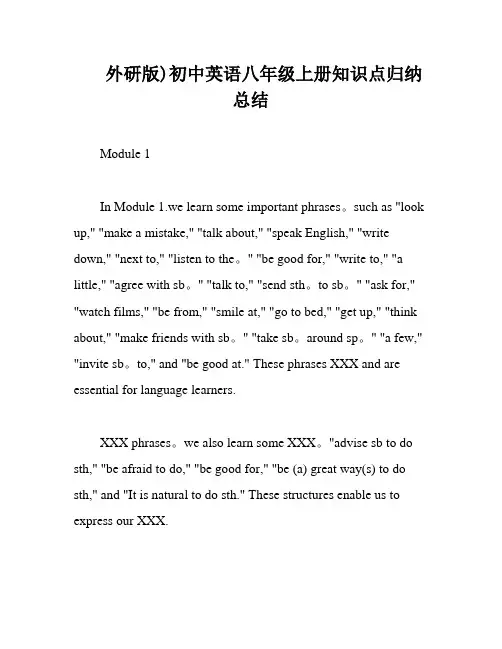
外研版)初中英语八年级上册知识点归纳总结Module 1In Module 1.we learn some important phrases。
such as "look up," "make a mistake," "talk about," "speak English," "write down," "next to," "listen to the。
" "be good for," "write to," "a little," "agree with sb。
" "talk to," "send sth。
to sb。
" "ask for," "watch films," "be from," "smile at," "go to bed," "get up," "think about," "make friends with sb。
" "take sb。
around sp。
" "a few," "invite sb。
to," and "be good at." These phrases XXX and are essential for language learners.XXX phrases。
we also learn some XXX。
"advise sb to do sth," "be afraid to do," "be good for," "be (a) great way(s) to do sth," and "It is natural to do sth." These structures enable us to express our XXX.Finally。
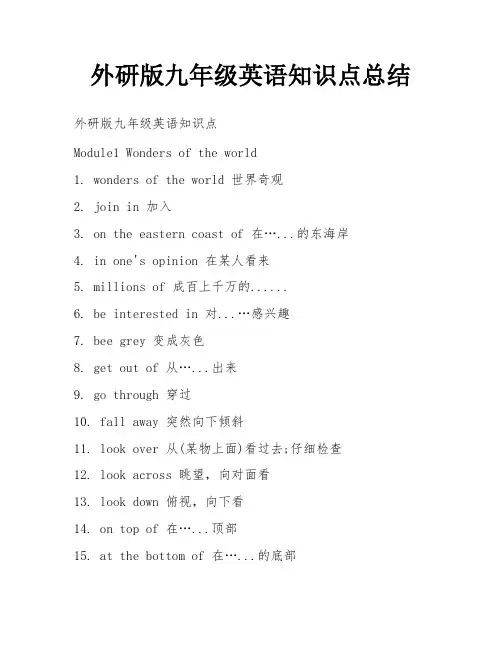
外研版九年级英语知识点总结外研版九年级英语知识点Module1 Wonders of the world1. wonders of the world 世界奇观2. join in 加入3. on the eastern coast of 在…...的东海岸4. in one's opinion 在某人看来5. millions of 成百上千万的......6. be interested in 对...…感兴趣7. bee grey 变成灰色8. get out of 从…...出来9. go through 穿过10. fall away 突然向下倾斜11. look over 从(某物上面)看过去;仔细检查12. look across 眺望,向对面看13. look down 俯视,向下看14. on top of 在…...顶部15. at the bottom of 在…...的底部16. on both sides 在两边17. look like 看起来像18. be famous for 因…...闻名19. do an interview 做采访20. draw a picture of 画一幅…...的图画21. go down 下去,下沉22. high up 在高处23. more than 超过24. dozens of 数十个,许多25. in height 高度,在高度上Module2 Public holidays1. as soon as 一…...就......2. take a vacation 度假3. have a picnic 野餐4. play music 演奏音乐5. go somewhere interesting 去有趣的地方6. make short speeches 做简短的演讲7. give thanks for 感谢......8. grow corn 种植玉米外研版九年级英语知识点梳理所谓垂悬结构(The Dangling Construction)就是一个句子成分,如分词短语,不定式动词短语等,找不到被修饰的主语或被修饰的对象不合逻辑。
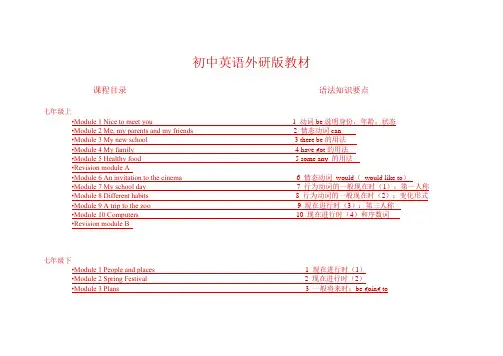
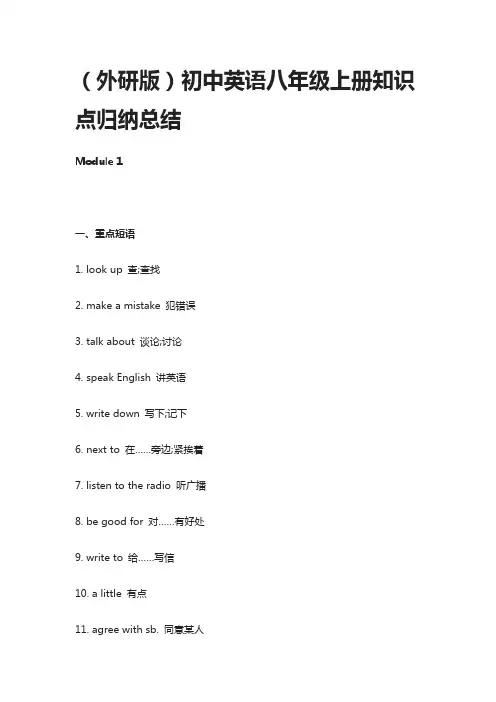
(外研版)初中英语八年级上册知识点归纳总结Module 1一、重点短语1. look up 查;查找2. make a mistake 犯错误3. talk about 谈论;讨论4. speak English 讲英语5. write down 写下;记下6. next to 在……旁边;紧挨着7. listen to the radio 听广播8. be good for 对……有好处9. write to 给……写信10. a little 有点11. agree with sb. 同意某人12. talk to 跟……交谈13. send sth. to sb. 把某物(发)送给某人14. ask for 请求15. watch films 看电影16. be from 来自17. smile at 冲……微笑18. go to bed 去睡觉19. get up 起床20. think about 考虑21. make friends with sb. 与某人交朋友22. take sb. around sp. 带领某人参观某地23. a few 几个;一些24. invite sb. to 邀请某人到……25. be good at 擅长26. for example 例如二、重点句型1. advise sb to do sth 建议某人做某事2. be afraid to... 害怕做……3. be good for... 对……有好处的4. be (a) great way(s) to do sth 做……的(一种)好方法5. It is natural to do sth. 做某事是合乎常情的。
三、重点语法1. Why not...? = Why don’t + you (we / they...)...?意为“为什么不……呢?”,后接动词原形。
eg:Why not / Why don’t we help the old cleantheir rooms this afternoon?今天下午为什么不去帮助老人打扫房间呢?2. What / How about...? 意为“……怎么样?”,其中about 是介词,后接名词或动词-ing 形式。
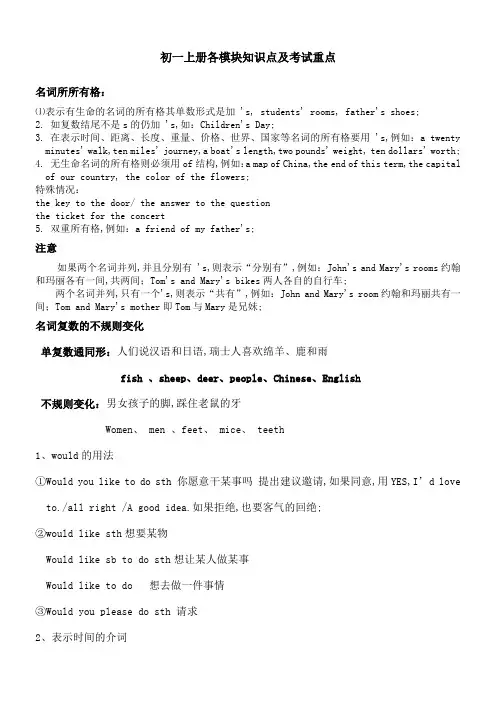
初一上册各模块知识点及考试重点名词所所有格:⑴表示有生命的名词的所有格其单数形式是加 's, students' rooms, father's shoes;2. 如复数结尾不是s的仍加 's,如:Children's Day;3. 在表示时间、距离、长度、重量、价格、世界、国家等名词的所有格要用 's,例如:a twenty minutes' walk,ten miles' journey,a boat's length,two pounds' weight, ten dollars' worth;4. 无生命名词的所有格则必须用of结构,例如:a map of China,the end of this term,the capital of our country, the color of the flowers;特殊情况:the key to the door/ the answer to the questionthe ticket for the concert5. 双重所有格,例如:a friend of my father's;注意如果两个名词并列,并且分别有 's,则表示“分别有”,例如:John's and Mary's rooms约翰和玛丽各有一间,共两间;Tom's and Mary's bikes两人各自的自行车;两个名词并列,只有一个's,则表示“共有”,例如:John and Mary's room约翰和玛丽共有一间;Tom and Mary's mother即Tom与Mary是兄妹;名词复数的不规则变化单复数通同形:人们说汉语和日语,瑞士人喜欢绵羊、鹿和雨fish 、sheep、deer、people、Chinese、English不规则变化:男女孩子的脚,踩住老鼠的牙Women、 men 、feet、 mice、 teeth1、would的用法①Would you like to do sth 你愿意干某事吗提出建议邀请,如果同意,用YES,I’d love to./all right /A good idea.如果拒绝,也要客气的回绝;②would like sth想要某物Would like sb to do sth想让某人做某事Would like to do 想去做一件事情③Would you please do sth 请求2、表示时间的介词At 后接时间点,周末at the weekendIn 用在年、月、季节或上午、下午、晚上等名词前On 后一般跟具体的某一天或某一天的上午、下午或晚上3、look、see、watch、readLook集中注意力看,强调看的动作,如跟宾语,要用atSee 强调看的结果,看见,看到Watch 强调专注地看,有欣赏的意味,常用语看电视,看球赛Read 阅读,看书1、would的用法①Would you like to do sth 你愿意干某事吗提出建议邀请,如果同意,用YES,I’d loveto./all right /A good idea.如果拒绝,也要客气的回绝;②would like sth想要某物Would like sb to do sth想让某人做某事Would like to do 想去做一件事情③Would you please do sth 请求2、表示时间的介词At 后接时间点,周末at the weekendIn 用在年、月、季节或上午、下午、晚上等名词前On 后一般跟具体的某一天或某一天的上午、下午或晚上初一下册重点知识2、形容词和副词形容词比较级用法:1.最明显的提示词是than,其结构为“A…+比较级+than+B”;2.有表示程度的副词a little,a bit,a few,a lot,much,even,still,far,rather,any等修饰时,用形容词比较级;3.表示两者之间进行选择“哪一个更…”时,句型“Which/Who is+形容词比较级,A or B ”4、表示“越来越……”,即“比较级+and+比较级”,多音节词和部分双音节词时用“moreand more+形容词原级”;5、表示“越……就越……”时,用“the+比较级,the+比较级”结构;形容词最高级用法:1.表示三者或三者以上的人或物进行比较时,用最高级形式;最高级前必须加定冠词the,句末常跟一个in/of短语来表示范围;2.表示在三者或三者以上的人或物进行选择时,用“Which/Who is+the+最高级,A,B or C ”3、表示“最……的……之一”时,用“one of the+形容词最高级”结构,4、形容词最高级前面可以加序数词,表示“第几最……一、词汇1、enjoyenjoy sth/doing 喜欢某物/做某件事情enjoy oneself= have a good time玩的愉快派生词:enjoyable,令人愉快的 enjoyment, 乐趣2、dress,put on, wear,be indress后常跟人作宾语,给…穿衣服,get dressed或dress oneself put on意为穿上,强调穿的动作,宾语通常是衣服、鞋帽wear穿着,戴着,强调穿的状态,宾语可以是衣帽也可以是饰品be in也表状态,后面要加颜色,表示穿着什么颜色的衣服3、 bring, take, carry 和get的用法;bring意思为“拿来”、“带来”;指将某物或某人从别处“带来”;Bring me the book, please.take意思是“拿走”,“带走”It looks like rain. Take a raincoat with you.carry 是“带着、搬运、携带”的意思, 不表明来去的方向;Do you always carry a handbagGet 是去某处将某物拿回来;Please go to my office to get some chalk.4、strict adj. be strict with sb.对某人要求严格be strict in sb 对某事要求严格5、spend人+spend+时间/金钱+ on sth/ in doing sth6、get ready forget ready for sth 为…做准备强调动作get ready to do sth 准备去做…强调动作be ready for sth 准备好… 强调状态be ready to do sth 准备好去做…强调状态get sth ready 把sth 准备好7、look forward to doing8、be good/bad atdo well/badly in9、hope 与wish的区别:希望去做… hope to do sth/wish to do sth希望sb去做… wish sb to do …hope与wish后都可以接that从句.二、金牌句型1、It is more difficult for old people to learn English.It is +adj.+for sb+to do sth.2、It is the best way to get to school.3、What’s the population of Shanghai在询问有多少人口用“What’s the population of…”/ “How large i s the population of…”表示“有多少人口”用“…have/has a population of…”形容人口的多少用large和small,而不用many,much和few,little4、有关how的疑问句短语How long… 多长时间或物体长度How soon… 过多久,用于将来时间How often… 频率How far… 多远,指距离5、What be sb like 询问某人什么样,可以是外貌或性格等;What do/does sb look like 询问相貌;初二上册考试重点一、语法1、时态的考察,对于各种时态主要看时间标志词,尤其是:just now/just/now; ago/before; five years ago/since five years ago/for five years, 时态的考察以现在完成时为重点,注意非延续性动词在现在完成加时间的情况下需要变为延续性状态的词;have been to /have been in/ have gone to2、反义疑问句祈使句Let引导的祈使句有两种情况:1Let's go home, shall we/ shan't we2Let us/me..., will you或won't you;Let me have a try, will you/won't you3动词原形开头的祈使句都用will you 或won’t you当陈述部分含I think believe, suppose...that... 结构时,其反意疑问句须与从句的主、谓语保持一致,注意主句的主语必须是第一人称;例如:I don't think he will come, will he若是非第一人称,则与主句的主语相一致He thinks that she will come, doesn’t he当陈述部分为从句时,若主句主语为 I ,反意部分的主语为从句主语;若不为 I ,反义部分的主语为主句主语;①I know your father is a worker, isn't he①she knows your father is a worker, doesn’t she当陈述部分含有以下这些含有否定意义的词时:few, little, seldom,hardly, never, not, no, no one, nobody, nothing, none, neither等,其反意疑问句需用肯定结构;例如: He is never late for school, is he陈述部分是there be句型时,其反意疑问句中要用there;There was a hospital here, wasn't there陈述部分的主语是everything, nothing, anything或something 时,反意疑问句的主语应用代词it;Something is wrong with my radio, isn't it 我的收音机出毛病了,是吧陈述部分的主语是 everybody, everyone, anybody, anyone, somebody, someone, nobody, no one, none, neither 时, 其反意疑问句的主语需用复数代词they;例如:Everyone is here, aren't they 大家都到了,是吗3、to do 不定式1. 不定式作主语时,常用it作形式主语,而将作主语的不定式放在句子后部;It is exciting to surf the Internet.It's ... of sb. to do sth.与It's... for sb. to do sth.形容词形容人的时候用of,形容事情的时候用forIt's very kind / nice of you to help me;It's hard for the Chinese students to learn Russian. 中国学生学俄语是很难的;2.动词不定式在句中作宾语,如带有宾语补足语时,要先用it作形式宾语,而将该不定式后置;注意:一些动词之后可以接to和doing作宾语时,如stop,forget,remember, try,need 等I don't think it right to do it in that way.我觉得以那种方式去做是不恰当的;I find it hard to get along with him.我发现与他相处不是件容易的事;4.作补语有些动词后跟不带to 的不定式作宾语补足语;①感官动词②使役动词③help sb. do…或help sb. to do当此类句子改为被动语态时,要补上to.He is often heard to sing this song.The workers were made to work 12 hours a day.在 think, find, consider, discover等动词后常用to be +adj.结构作宾补,有时to be 可省略;We all think/ consider/ find/ discover him to be kind and honest.动词不定式的省略1不定式在使役动词 let, have, make和感官动词 see, watch, notice , observe, hear, smell, feel, find 等后作宾补时,省略to;help 可带to,也可不带to →help sb to do sth;2 Why not 后面接不带to 的不定式;常用来表建议;Why not have a break3but和except:but/except前的部分出现实义动词do时,其后面出现的动词不定式可以不带to;比较:He wants to believe anything but to take the medicine.Last night I did nothing but to watch TV.He does everything except to work.4 由and, or或than连接的两个不定式,第二个不定式的to 可以省去;例如:He wants to move to France and marry the girl.5通常在discover, imagine, suppose, think, understand等词后,可以省去to be:He is supposed to be an honest man.4、情态动词must是重点1表示义务;意为“必须”主观意志;否定形式是needn’t,2表示揣测;意为“想必、准是、一定”等,只用于肯定句;否定形式是can’t3musn’t本身表示“禁止”,“不允许”,“不能”二、重点词汇、句型1、※What/how about doing …※Why not/wh y don’t you do…..※It is +adj.+for sb to do sth 此句型到第九模块会重点讲解2、※other 系列词3、※4、※ no one 和none5、bring, take, carry 和get的用法;bring意思为“拿来”、“带来”;指将某物或某人从别处“带来”;Bring me the book, please.take意思是“拿走”,“带走”,把某物或某人从这里“带来”或“拿到”某处之意;It looks like rain. Take a raincoat with you.carry 是“带着、搬运、携带”的意思,指随身携带,有背着、扛着、抱着、提着的含义,不表明来去的方向;Do you always carry a handbagGet 是去某处将某物拿回来;Please go to my office to get some chalk.6、through/across/overthrough 穿越,指从空间内穿越 through the dooracross,横越穿过,从表面走过,或从一边到另一边,across the roadover翻越,跨越7、provide /offerprovide sth for sb / provide sb with sthoffer sth to sb / offer sb sth主动提供8、happen / take placehappen指事件偶然发生,还可以表示“碰巧”之意,不用于被动语态sth happen to sbsb happen to do sth.It happens that+句子take place多指按计划或者安排而发生,不用于被动语态9、compare…with…比较compare…to…. 比喻10、depend on sb 依赖depend on sth 依…而定初二下册重点知识一、重点词汇1、makemake +宾语+动词原形 He made us stay with him.make +宾语+ 形容词 He tried to make his mother happymake +宾语+名词- He made me his friend.make +宾语+介词短语 He asked us to make ourselves at home.make +宾语+过去分词 What made him so frightened2、seemSeem+形容词 English seems a little difficult.Seem to do He doesn’t seem to have any friends.=It seems that he doesn’t have any friends.It seems as if they were in a dream.3、suggestsuggest+名词、代词suggest doing建议做某事suggest sb do 建议某人做某事4、refuse to do sth拒绝做某事5、beat 打败,后接运动员、球队、对手win 接比赛、战争,奖项6、avoid doing sth避免做某事7、dependdepend on sb 依赖depend on sth 依…而定8、on one’s own独自of one’s own 某人自己的9、have problem with …在哪一方面有麻烦have problem/trouble/difficulty indoing,其中trouble/difficulty是不可数名词,前面用no/much/some/little any修饰10、come up出现,发生1发芽,In March, lots of plants begin to come up.2太阳升起3发生,出现I'll let him know if anything comes up.4被提及A number of questions came up at the meeting.11、in order to、to+动词原形、so as to,so…that.so that,in order thatin order to、to+动词原形、so as to引导目的状语从句,有时为了表示强调,也可把in order to,to do放在句首,否定形式是in order not to,so as not to12、as well as并且,还,可与not only…but also互换,但是as well as强调前面的内容,not only…but also强调后面的内容1连接两个并列成分He as well as his friends likes going shopping.2as well as还可以表示“和…一样好”,well是副词,用于修饰实义动词;3as well 可单独做副词,表示“也”,位于句末;13、such adj. 如此,这样so +adj.+a/an+单数名词such+a/an+adj.+单数名词such +adj.+复数名词、不可数名词,当adj.是many/much/few/little时用so14、倒装句So + be/助动词/情态动词+主语“某人或某物也一样”I will go there tomorrow. So will she.So +主语+be/助动词/情态动词“的确如此”"It was very cold yesterday.""昨天很冷;""So it was.""的确如此;"对于上述两种情况,当前一句是否定句时, so须改用neither或nor;15、besides,but,except和except forbesides:除了......还包括He has another car besides this.but与excep t同义,但but多用在every,any,no等和由这些词构成的复合词except:除了;例句:Except you, there is no one can help me. 除了你没人能帮我except for:在一类中除去另一类,Smith is a good man, except fo r his bad temper二、语法知识1、宾语从句宾语从句的语序宾语从句的语序应为陈述句的语序;例如:I hear that physics isn’t easy.I think that you will like this school soon.Can you tell me how I can get to zooPlease tell me when we’ll have the meeting.宾语从句的时态如果主句的时态是一般现在时,宾语从句该用什麽时态就用什麽时态;I don’t think that you are right.Please tell us where he is.Can you tell me how I can get to the railway station如果主句的时态是一般过去时,宾语从句只能用相应的过去时态一般过去时, 过去进行时, 过去将来时,过去完成时;例如:He asked what time it was.He told me that he was preparing for the sports meet.He asked if you had written to Peter.知识拓展:宾从的主语与主句的主语或宾语相同时,可把从句替换为“疑问词 + to d o”①.I haven’t decided where I will go =I haven’t decided where to go②.He asked me what I bought = He asked me what to buy.2、状语从句★时间状语从句1由 when,as soon as ,before 等引导的时间状语从句用一般现在时表示将来时间;2带有till或until引导的时间状语从句的主从复合句里,如果主句用肯定式,其含义是“一直到……时”,谓语动词只能用延续性动词;如果主句用否定式,其含义是“直到……才……”, “在……以前不……”, 谓语动词可用瞬间动词;例如:The young man read till the light went out.We won’t start until Bob comes.★条件状语从句1条件状语从句遵循“主将从现”原则,一般现在时表示将来时间;2“祈使句 + and or+ 陈述句” 在意思上相当于一个带有条件状语从句的复合句;Hurry up, or you’ll be late. =If you don’t hurry up, you’ll be late.★结果状语从句结果状语从句由so…that, such…that, so that此知识点牵扯到重点词汇中的 so +adj.+a/an+单数名词such+a/an+adj.+单数名词such +adj.+复数名词、不可数名词,当adj.是many/much/few/little时用so3、to do 和doing做宾语常考的动词后加-ing.1. Enjoy doing sth 喜欢做某事2. Like doing sth 喜欢做某事3. Have fun doing sth 玩得开心4. Practice doing sth 练习做某事5. Spend doing sth 花费时间做某事主语是人6. Keep doing sth 保持一直做某事7. How about doing sth 做某事怎么样表建议8. What about doing sth 做某事怎么样表建议9. Have a difficulty doing sth 做某事有困难10. Have a good time doing sth 玩得开心11. Feel like doing sth 想要做某事12. Can’t help doing sth禁不住做某事13. start doing sth 开始做某事14. go on doing sth 继续做某事15. mind doing sth 介意做某事16. finish doing sth 完成做某事17. be busy doing sth 忙于做某事18. see/hear sb doing 看到/听到某人正在做某事19. remember doing sth 记住曾做过某事20. forget doing sth 忘记曾做过某事21. try doing sth 做某事试试看有何效果22. mean doing sth 意味着做某事23. can't help doing sth 禁不住做某事24. stop doing sth. 停止正在做的事初三上册考试重点知识一、语法知识1、时态被动语态的特殊用法:1、不及物动词带介词和介词宾语,在变为被动语态时,仍然要带上介词,如The teacher is listened to carefully by the students in class.The new students are looked after in the school.The things are take good care of .2、当动词带有符合宾语时,并且宾补是省去“to”的动词不定式时,在被动语态中应加上“to”,一感,二听,三让,四看They make us do all the work. We are made to do all the work.We often hear her sing English songs. She is often heard to sing English songs.I see him walk to school. He is seen to walk to school.3、当动词带双宾语时,将其中一个宾语提前作被动语态的主语,另一个不动; 如果是将指物或指事的宾语提前,则指人的宾语前应加上 to、for如:I am given some nice presents.They give me some presentsSome nice presents are given to me.The children are often told some stories byhimHe often tells the children some stories.Some stories are often told to the children by him.动词后加to:give,show,send,bring,lend,promise等;动词后加for: pay,buy,sing,make,get等3、定语从句修饰人只用who的情况:a. 先行词是one , ones , anyone , those 时;b. there be句型中修饰名词时;c. 先行词后有一个较长的定语;1Anyone who hasn’t handed in his home- work should stay after school.2There is a girl who wants to see you at the school gate.3Did you see the man in the park yesterday afternoon who wore a red shirt 修饰人或物只用that的情况:1 先行词是all, few, little, nothing, everything, anything 等不定代词时; All that he said is true.2 先行词被only, no, any, all,等词修饰时;He is the only foreigner that has been to that place.3 先行词是序数词或被序数词修饰的词;例如:He was the second person that told me the secret.4 先行词是形容词最高级或被形容词最高级修饰的词;This is the best book that I have read this year.5 先行词既包括人又包括物时;例如:修饰物只用which的情况:a. 先行词在定语从句中作介词的宾语时b. 先行词为that时1This is the house in which Lu Xun once lived . 这就是鲁迅以前住过的房子;2What’s that which you are holding in your arms 你抱着的那个是什么定语从句可简化为短语1.定语从句为被动语态时可简化为过去分词短语;定语从句为现在进行时可简化为现在分词短语;2.定语从句的谓语be后是介词短语,可简化为介词短语作定语;3.定语从句的谓语动词含情态动词,可简化为不定式;eg.1I bought a book that was written by Lu Xun.= I bought a book written by Lu Xun.2Tell the children who are playing there not to do that.= Tell the children playing there not to do that.3The book that is on the table is mine.= The book on the table is mine.4 We have nothing that we should fear.= We have nothing to fear.4、冠词和数词1、a/an用在序数词之前表示“再一次,又一次’2、the用在姓氏复数之前,表示“某某一家人”,“某某夫妇”;例如:the Browns, the Whites等;3.表示一个具体数字时,hundred, thousand, million一律不用复数;在表示一个不确定数字时则用复数;例如:There are three thousand students in our school.After the war, thousands of people became homeless.3 表示“……十”的数词的复数形式可用来表示人的岁数或年代,例如:He is in his early thirties.He died still in his forties.This took place in 1930s.5、主谓一致1. 语法一致的原则2并列主语如果指的是同一人,同一事物或同一概念,谓语动词用单数;例如:His teacher and friend is a beautiful girl.The poet and writer has come.3由and连接的并列单数主语之前如果分别由each, every修饰时,其谓语动词要用单数形式;例如: In our country every boy and every girl has the right to receiveeducation.4主语是单数时,尽管后面跟有 but ,except, besides, with ,as well as等短语,谓语动词仍用单数;例如:The teacher with his students is going to visit the museum.5 一些只有复数形式的名词,如people, police, cattle, clothes等作主语时,谓语动词要用复数;The police are looking for lost boy.7有两部分构成的物体的名词,如glasses, shoes, trousers, chopsticks, scissors 等作主语时,谓语动词用复数;例如:Where are my shoes I can’t find them.Your trousers are dirty. You’d b etter change them.如果这类名词前用了a pair of等,则往往用作单数,谓语动词的单复数形式往往取决于pair的单复数形式;例如: My new pair of socks is on the bed.2. 意义一致的原则1表时间、距离、价格、度量衡等的名词作主语时,谓语动词通常用单数;例如:Twenty years is not a long time.Ten dollars is too dear.2有些集合名词,如family, team等作主语时,如作为一个整体看待,谓语动词用单数;如指其中每个成员,则用复数;例如:My family is big one.My family are watching TV.5“分数或百分数/the rest+of+名词”构成的词组作主语时,其谓语动词要以of后面的名词而定;名词是复数,谓语动词用复数:名词是单数,谓语动词用单数;例如:It is said that 35 per cent of the doctors are women.Three –fourths of the surface of the earth is sea.8凡是以“定冠词+形容词或分词”作主语,往往根据意义一致的原则决定谓语动词的单复数形式;如果这种主语指的是一类人,谓语动词用复数;如果指的是一个人或抽象概念,谓语动词用单数形式;例如:The sick have been cured and the lost have been found.The dead is a famous person.3. 邻近一致的原则1由连词or, either……or,neither……nor, not only…but also,等连接的并列主语,如果一个是单数,一个是复数,则谓语动词按就近一致原则,与最靠近它的主语一致;例如:Either you or I am right.Neither the children nor the teacher knows anything about it.2在“There be” 句型中,谓语动词和靠近的主语一致;There are two apples and one egg in it.4以here开头的句子,其谓语动词和靠近的主语一致;Here is a letter and some books for you.词汇1、do some reviews about表示“对......做评论”;do an interview with表示“采访......”.2、too……to 太……而不能He is too young to go to schoolso…that 如此…以至于,…enough to…,注意同义句转换3、as far as 就…而言,据…as long as 只要:I don't mind as long as it doesn't rain.as soon as一…就…I'll write you as soon as I get there.as well as和…一样He grows flowers as well as vegetables.4、please两个意思,一个是请,一个是取悦,Mark treid to please Jen.pleased,感到愉悦的,高兴的pleasure,名词,相当于fun,can you open the door for me My pleasure.pleasant,是形容词,舒服的,宜人的such a pleasant day5、allow/encourage/advise sb to dosb be allowed/encouraged/advised6、prefer to do…rather than do…prefer doing A to doing Bwould rather do …than do…would rather do…than do….do A instead of doing B7、above all,after all,first of all,in allabove all,尤其是,最重要的是,强调内容的重要性after all 毕竟,终究first of all 首先,表示顺序上的首先in all 总共8、instead of /insteadinstead of 是介词短语,常位于句中,而instead是副词,可置于句中,常用逗号与句子主干分开,也可直接置于句末,通常用于上文已经说明的被代替的对象;He is too busy, let me go instead.9、in order to、to+动词原形、so as to,so…that.so that,in order thatin order to、to+动词原形、so as to引导目的状语从句,有时为了表示强调,也可把in order to,to do放在句首,否定形式是in order not to,so as not to10、some time 一段时间sometime 某个时候sometimes 有时候some times 几次11、be used to do 被用来做某事be used to dong 习惯于used to do 曾经12、no one 和none13、so +adj.+a/an+单数名词such+a/an+adj.+单数名词such +adj.+复数名词、不可数名词,当adj.是many/much/few/little时用so14、be supposed to do被期望或要求; 应该suppose that假定15、progress,不可数名词make progress16、倒装句So + be/助动词/情态动词+主语“某人或某物也一样”I will go there tomorrow. So will she.So +主语+be/助动词/情态动词“的确如此”"It was very cold yesterday.""昨天很冷;""So it was.""的确如此;"对于上述两种情况,当前一句是否定句时, so须改用neither或nor;初三下册知识重点一、词汇1、debate v.&n.辩论1debate about sth.争论某事2debate with sb.与某人争论2、neither 和none1neither“两者都不”,是both的反义词,neither,neither of作主语时,谓语动词用单数形式,Neither of the two boys is right.N either…nor…既不…也不…,主谓一致遵循就近原则2none 三者或三者以上都不,none和none of做主语时,谓语动词单复数皆可;3、prevent防止,预防主要考点:prevent ;;;from sth/doing sth 阻止…做…=keep /stop …..from…..4、absent缺席的,不在场的反义词:present短语:be absent from缺席5、supposebe supposed to do被期望或要求; 应该suppose that假定6、lead a…life过着…的生活7、关于off的词组Set off 出发put off 推迟give off发出〔光、热、气味等〕Get off 下车turn off 关闭hurry off匆忙离开... Fall off 跌落go off 爆炸8、fit 合适,合身9、success 名词,成功 The meeting is a great success.successful 形容词,成功的 The meeting is successful.succeed 动词,成功 He succeeded in teaching.10、suggestion 可数名词 some suggestionsadvice 不可数名词 some advice 、 a piece of advicesuggest sb do sth advise sb to do sth11、do damage to 对…造成损害do harm/good to 对…有害no good doing做某事没好处no good to sb 对某人无益12、make effort to do sth努力去做某事13、miss1想念 I will miss you.2错过 He missed the train.3不见了 Who is missing14、a large amount of 大量的,修饰可数名词复数形式;只修饰名词复数:many / several/ a few / few/ alarge number of 只修饰不可数名词:much/ a little/ a great deal of即可修饰不可数名词又可修饰名词复数的:a lot of/plenty of15、have effect on对;;;造成影响make differences to 对…造成影响16、give in 屈服give up 放弃17、in other words换句话说in a word 总而言之have words with sb 和某人吵架18、help oneself to 慢慢享用19、not…any more不再数量上不再=no more 但是在句子中的位置不同not …any longer时间上不再= no longer20、be named after;;;以;;;命名21、above all,after all,first of all,in allabove all,尤其是,最重要的是,强调内容的重要性after all 毕竟,终究 at fist 开始,起先,带有转折之意first of all 首先,表示顺序上的首先 in all 总共22、achieve完成,达到,收获achieve a high levelachieve great progress23、no matter…无论… 引导让步状语从句之后加疑问词24、in place of代替与instead ofinstead of代替……,而不是……用在名词,代词或介词短语前We will go by bus instead of on foot.我们坐车去,而不是步行;in place of与instead of意思相同;书面语,代替某人可说in sb's placeWe use gas in place of coal in cooking.我们用煤气代替煤作饭Our monitor is away. I am action in place of him.我们班长不在,我代替他的职务.take the place of 取代,代替做谓语,用在名词,代词前Tractors have taken the place of horses in many places.在许多地方拖拉机代替了马25、be essential fo r …对…极其重要26、What’s more 并且,进一步说27、from the bottom of one’s heart 由衷地…28、owe to 归功于owe sth to sth 把…归功于…owe sth to sb 欠某人某物29、pay back 偿还30、apply for 申请二、语法知识感叹句:感叹句是表示喜、怒、哀、乐以及惊异等感情的句子;句末用感叹号“”,读时用降调,感叹句往往由what或how引导,what修饰名词,how修饰形容词,副词或动词;1. what引导的感叹句:1what + a/an +形容词+单数可数名词+陈述句主语+谓语What a beautiful city it isWhat an interesting story she told2what+形容词+复数可数名词/不可数名词+陈述句主语+谓语What expensive watches they areWhat terrible weather it is2.How引导的感叹句:1How+形容词/副词+陈述句主语+谓语How cold it isHow hard he works2How+陈述句主语+谓语How he loves his sonHow I miss you3How+形容词+a/an+单数可数名词+陈述句主语+谓语How tall a tree it is4上述两种感叹句可以互相转换;例如:What a clever boy he is→How clever the boy isWhat a cold day it is→How cold it is。
九年级英语上册知识点总结Module1 Wonders of the world一、重点短语1.wonders of the world世界奇观2.natural wonders自然奇观3.join in = take part in参加;加入(活动)4.agree with sb.同意某人的看法5. agree to do sth.同意做某事6.in one’s opinion依某人看来;按某人的意见7.more than = over多于,超过8. millions of数百万的;数以百万计的9.produce electricity供电10.would like to do sth. = want to do sth.想做某事11.get out of...从....出来12.become grey变成灰色13.look across眺望, 向对面看14.look down to俯视;向下看15.go down下去;下沉;坠落16.look over从(某物上面)看过去:仔细检查17. go through穿过,经历,经受,浏览18.at the bottom of在.....的底部19.on both sides在两边20.in height高度;在高度上21. do an interview with sb.采访某人22.draw a picture of画一副......的图画23.fall away突然向下倾斜24.wait for等候25.dozens of许多26.be famous for以.......而闻名二、固定结构1. sb./sth agrees with sth.某人/某物适应(食物、气候)/符合某物,I don't think the food here agrees with me. 我觉得这里的食物不对我的胃口His explanation agrees with the facts of the situation.他的解释与实情相符。
七年级上册外研版英语课堂笔记一、Module 1 My classmates。
1. 重点单词。
- nice:adj. 美好的;令人愉快的。
例如:She is a nice girl.(她是一个好女孩。
)- to:prep. 到;向。
例如:Welcome to Beijing.(欢迎来到北京。
)- meet:v. 遇见;结识。
例如:Nice to meet you.(很高兴见到你。
)- classmate:n. 同学。
例如:He is my classmate.(他是我的同学。
)- his:pron. 他的。
例如:His name is Tom.(他的名字是汤姆。
)- her:pron. 她的。
例如:Her book is very interesting.(她的书非常有趣。
)2. 重点短语。
- be from:来自。
例如:I am from China.(我来自中国。
)- Nice to meet you:很高兴见到你。
这是初次见面时常用的打招呼用语,回答通常是“Nice to meet you too”。
3. 重点句型。
- What's your name? 你叫什么名字?这是询问他人名字的常用句型,回答可以是“My name is...”或者“I'm...”。
- I'm from... 我来自……,用来介绍自己的籍贯。
例如:I'm from Shanghai.(我来自上海。
)二、Module 2 My family。
- family:n. 家;家庭。
例如:This is my family.(这是我的家庭。
)- father:n. 父亲;爸爸。
例如:My father is a teacher.(我的爸爸是一名教师。
)- mother:n. 母亲;妈妈。
例如:My mother likes cooking.(我的妈妈喜欢做饭。
)- sister:n. 姐妹。
例如:My sister is a student.(我的姐姐是一名学生。
外研版英语【初中英语】非谓语动词知识点总结一、非谓语动词1.Our teacher often tells us in the river. It's dangerous.A. not swimB. not to swimC. to swimD. swimming 【答案】 B【解析】【分析】句意:游泳是危险的。
题目中的 tell(告诉)是谓语,句子在连接第二个动词时,需要用 to 来连接,将其非谓语化,既不定式:to +动词原形。
可以排除 A 和 D。
所以可以推断出老师是告诉我们不要去游泳。
因此选择不定式的否定形式,故答案为B。
【点评】考查动词不定式,熟记固定搭配。
2.When you are tired, in the countryside is a wonderful experience.A. relaxingB. relaxedC. relaxD. relaxes【答案】 A【解析】【分析】考查非谓语动词。
句意:当你累的时候,在农村放松是一个奇妙的体验。
所填动词在句中作主语,该用动名词形式,所以选A。
3.一What should we take when going birdwatching? 一 We should take a pair of binoculars ____________the birds clearly.A. seeB. seeingC. to seeD. sees【答案】C【解析】【分析】句意:一去看鸟应该带什么?一为了看得清楚,我们应该带一副望远镜。
带上望远镜的目的是看得清楚,用带to的不定式作目的状语。
故选C。
4.My parents didn't allow me ______ to the party.A. goB. to goC. goesD. went【答案】 B【解析】【分析】:本题考点为非谓语动词(固定用法)。
allow sb. to do sth.,即“允许某人做某事”。
外研社英语初一(上册)英语知识点MUDULE 1 1、同义句1. M y name's Daming. = I'm Daming.2. I'm from England. = I come from England.3.Are you a new student ?≈ Are you new?4.Nice to meet you. = Nice to see you. =Glade to meet you. = Glade to see you.5.What's your name ?= May I have your name ? 2、特殊疑问句—What's your name?—How old are you? = Can you tell me your age? —My name is ....= What's your age?—I'm twelve years old. —Where are you from? —What class are you in?—I'm from... —I'm in Class One, Grade One.3、单词短语1.practise + ding sth.2.with &and A and B go to the bank.A withB goes to the bank.4、形容性物主代词I--my you--your he--his she--her it--its we--our you--yourthey —themMUDULE 2 1、单词职业:doctor manager secretary worker teacher工作地点:factory hospital hotel office school university 2、短语playbasketball football tennistable tennis the pianoride a bike\horsespeak English\Japanese\Chinese sing (a song) swima photo\picture of my familya universityan office三、语法(can)twofactories citiesuniversities secretariesCan do sth. I can\can't ride a bike. Can you ride a bike? Yes, I can.\No, I can't. 四、句子He\She is a ... They're ...重难点:1. play 与不同的名词搭配时所表达的意思是不同的,play 与球类搭配时是不需要加定冠词the ,如:play football ,basketball ,volleyball and so on.Play 与乐器搭配时是需要加定冠词the ,如:play the piano ,the guitar and so on.2. 固定搭配:ride a bike/horse,speak English/Japanese/Chinese,sing a song,swim.3. 不定冠词 a 与 an 的用法4. 语法知识:Can 的用法 Can do sth Can+主语+do sth ? Yes ,主语+can./No ,主语+can’t.I can’t do sth.5. What does your ... do?=What is\are you ...'s job?=What is your ...?He\She is a ... They're ...MUDULE 3 1、单词1.buildings in school: classroom dining hall gym library office science lab2.something: blackboard book classroom computer desk dictionary football library picture television3. n umbers: thirteen fourteen fifteen sixteen seventeen eighteen nineteen thirty forty fifty sixty seventy eighty ninety4. 介词:next to ≈ near behind ≠ in front of in on under5. in front of:在 ........... 前面in the front of:在 ........... 里面的前面 6. r ight 正确的≠wrong右边的≠left2、语音 er 、or 、ur 发/ə/3、语法(There be)----Are there any school offices?----No, there isn't. 注意:1.就近原则:There is some meat and two apple on the desk. 2.名词所有格: Miss Li's herLily and Lucy's 两人共有的 eg:Lily and Lucy's father. Lily's and Lucy's 两人各有的 Lily's and Lucy's fathers.重难点:1. 重要单词: classroom dining hall gym library officesciencelab blackboard book classroom computer desk dictionary football library2. 介词的用法: next to ≈ near behind ≠ in front of in on under3. i n front of 与 in the front of 的区别4. 语法知识alk----Is there a computer on Miss Li's desk? ----No, there isn't.就近原则:There is some meat and two apple on the desk. 5.名词所有格:MUDULE 41、family members:aunt uncle grandma grandmother grandpa grandfather mother father mum dad sister brother 2、短语句型Thank you for your email. your help. thank (sb.) for sth.about sth.t with sb. helping me. asking me. thank (sb.) for doing sth. say to sb.it againMake a family tree for your family.----How many people are there in your family?----There are four. There are my mum and dad, my sister and me. ----Have you got an aunt?/any ..... ? ----Yes,I have./No,I haven't.----Have you got a small family or a big family? ----I've got a big family.(选择疑问句) or 的用法:① 或; ② 并列否定:I don't like swimming or dancing.重难点:1..重要短语:Thank you for doing sth./Thanks for doing sth. 3.have got 的用法 4.重难点: or 的用法:① 或; ② 并列否定:I don't like swimming or dancing.MUDULE 5-61、单词1. orange 橙 汁 have some orange [U ]橙 色 the oranges are orange [C ] 橙 子 This is an orange [C ]2. K ind 善 良 He is very kind.种 类 =type a kind / type of fruit two kinds /types of fruits3. gym: 不受天气影响的室内体育馆、健身房或运动馆stadium: 周围有看台的露天大型运动场 4. h ealthy ≠ unhealthy keep/stay healthyin good health ≠ in poor/bad health be healthy = be in health5. good for one health ≠ bad for one health条件 变化形式 例词1.重要单词:orange 三个不同的含义,health(n.)与healthy(adj.)的区分.2.重要短语与句型:详见知识点概括MUDULE 71、短语about sth.谈论某事talk to sb. 跟某人谈话(一方讲一方听)with sb. 跟某人谈话(双方都讲)sth.(my homework)start to do sth.(to do my homework)doing sth.(doing my homework)finishsth.(my homework)doing sth.(doing my homework)get up≠go to bedgo home≠leave home(for)study science/history/chemistry/mat2、语法①时间表达法:What's the time?What time it is? (问时间具体几点钟)直读法: It's two ten. (2:10)逆读法:①It's ten past two.(2:10)≤30'②It's ten to ten.(2:50) >30'整点表达法:It's two o'clock. (2:00) (不用介词)注意:1. a quarter past two 2:15a quarter to two 2:45half past two 2:302.half an hourcut the apple into two halves3.When do you get up?What time do you get up? (问具体几点钟做某事)I get up atWhen is your birthday / the film?(问日、月、年或某事何时发生)②一般现在时(1)【No. 1】一般现在时的功能1.表示事物或人物的特征、状态。
外研版七年级英语语法整理一、介词(Prepositions)介词是一种在句子中表示关系的词语,常见的介词有:at, in, on, to, by, with等。
1.在时间和地点上使用介词:•at:用于“某一时刻”或“某一时间点”,如at 8 o’clock / at night / at the weekend;•in:用于“持续一段时间”,如in the morning / in summer / in 2005;•on:用于“某一天、日期或节日”,如on Monday / on December 25th / on Christmas Day。
2.表示方向的介词:•to:表示“朝向某个地方”,如go to school / walk to the park;•from:表示“从某个地方来”,如come from Beijing;•into:表示“进入某个地方”,如go into the room;•out of:表示“离开某个地方”,如get out of the car。
3.还有其他表示方式的介词:•by:表示“通过某种方式”,如by bus / by bike;•with:表示“伴随着某人或某物”,如with my parents / with a pencil;•for:表示“为了某人或某物”,如buy a gift for my friend。
二、冠词(Articles)冠词是一种词类,分为定冠词(the)和不定冠词(a / an)。
1.不定冠词的使用:•a:用于单数名词以辅音音素(consonant)开头的情况,如a book / a desk;•an:用于单数名词以元音音素(vowel)开头的情况,如an apple / an egg。
2.定冠词的使用:•the:用于特定的人或物,表示“唯一性”,如the sun / the moon / the school。
3.不使用冠词:•一般情况下,不使用冠词表示泛指或抽象意义,如I like music(我喜欢音乐)。
外研初中英语知识点总结一、词汇与短语1. 基础词汇:掌握日常生活、学习、工作中常用的英语单词,如颜色、数字、食物、职业等。
2. 短语动词:了解并运用常见的短语动词,如look after, give up, find out等。
3. 常用短语:熟悉并正确使用日常交流中的短语,如make a decision, take care of, get along with等。
二、语法知识1. 时态:- 一般现在时:表示经常性或习惯性的动作,如I go to school every day.- 一般过去时:描述过去发生的动作或状态,如He visited the museum last week.- 一般将来时:表达将来要发生的事情,如They will travel to Japan next year.- 现在进行时:表示正在进行的动作,如She is reading a book now.- 过去进行时:描述过去某一时刻正在进行的动作,如He was watching TV when I called him.- 将来进行时:用于表达将来某一时刻正在进行的动作,如I will be working at that time tomorrow.2. 语态:- 被动语态:表示动作的承受者,如The book was written bythe author.- 进行时态的被动语态:如The car is being repaired.3. 非谓语动词:- 动名词:作为名词使用,如Swimming is my favorite sport. - 分词:现在分词和过去分词,如interesting (现在分词), broken (过去分词).- 不定式:to + 动词原形,如I want to learn English.4. 情态动词:表达可能性、能力、许可等,如can, could, may, might, must, should等。
外研社英语初一(上册)英语知识点MUDULE 1一、同义句1.My name's Daming. = I'm Daming.2.I'm from England. = I come from England.3.Are you a new student ?≈ Are you new?4.Nice to meet you. = Nice to see you. =Glade to meet you. = Glade to see you.5.What's your name ?= May I have your name ?二、特殊疑问句 —What's your name ? —How old are you? = Can you tell me your age?—My name is .... = What's your age?—I'm twelve years old.—Where are you from? —What class are you in?—I'm from... —I'm in Class One, Grade One. 三、单词短语1.practise + ding sth.2.with &and A and B go to the bank.A withB goes to the bank.四、形容性物主代词I--my you--your he--his she--her it--itswe--our you--your they —themMUDULE 2一、单词职业:doctor manager secretary worker teacher工作地点:factory hospital hotel office school universitya photo\picture of my family 三、语法(can)Can do sth. I can\can't ride a bike.Can you ride a bike? Yes, I can.\No, I can't.四、句子twoHe\She is a ... They're ...重难点:1. play 与不同的名词搭配时所表达的意思是不同的,play 与球类搭配时是不需要加定冠词the ,如:play football ,basketball ,volleyball and so on.Play 与乐器搭配时是需要加定冠词the ,如:play the piano ,the guitar and so on.2. 固定搭配:ride a bike/horse,speak English/Japanese/Chinese,sing a song,swim.3. 不定冠词a 与an 的用法4. 语法知识:Can 的用法 Can do sth Can+主语+do sth ? Yes ,主语+can./No ,主语+can ’t. I can ’t do sth.5. What does your ... do?=What is\are you ...'s job?=What is your ...?He\She is a ... They're ...MUDULE 3一、单词1.buildings in school: classroom dining hall gym library office science lab2.something: blackboard book classroom computer desk dictionary footballlibrary picture television3.numbers: thirteen fourteen fifteen sixteen seventeen eighteen nineteenthirty forty fifty sixty seventy eighty ninety4.介词:next to ≈ near behind ≠ in front of in on under5. in front of:在......前面in the front of:在......里面的前面6.right 正确的≠wrong右边的≠left二、语音 er 、or 、ur 发/ə/三、语法(There be)----Are there any school offices?----No, there isn't.注意:1.就近原则:There is some meat and two apple on the desk.2.名词所有格:Miss Li's herLily and Lucy's 两人共有的 eg: Lily and Lucy's father.Lily's and Lucy's 两人各有的 Lily's and Lucy's fathers.重难点:1.重要单词: classroom dining hall gym library office science lab blackboard book classroom computer desk dictionary football library2.介词的用法: next to ≈ near behind ≠ in front of in on under3.in front of 与 in the front of 的区别4.语法知识----Is there a computer on Miss Li's desk?----No, there isn't.就近原则:There is some meat and two apple on the desk.5.名词所有格:MUDULE 4一、family members:aunt uncle grandma grandmother grandpa grandfather mother father mum dad sister brother二、短语句型Thank you for your email. your help. helping me. asking me. Make a family tree for your family.----How many people are there in your family?----There are four. There are my mum and dad, my sister and me.----Have you got an aunt?/any .....?----Yes,I have./No,I haven't.----Have you got a small family or a big family?----I've got a big family.(选择疑问句)or 的用法:① 或; ② 并列否定:I don't like swimming or dancing.重难点:1..重要短语:Thank you for doing sth./Thanks for doing sth.3.have got 的用法4.重难点: or 的用法:① 或; ② 并列否定:I don't like swimming or dancing.MUDULE 5-6一、单词1. orange 橙汁 have some orange [U ]橙色 the oranges are orange [C ]橙子 This is an orange [C ]2.Kind 善良 He is very kind.种类=type a kind / type of fruit two kinds /types of fruits3. gym: 不受天气影响的室体育馆、健身房或运动馆stadium:二、短语1.重要单词:orange三个不同的含义,health(n.)与healthy(adj.)的区分.2.重要短语与句型:详见知识点概括MUDULE 7一、短语talk to sb. 跟某人谈话(一方讲一方听)get up ≠go to bed go home ≠leave home(for) 二、语法 ①时间表达法:____ What's the time? What time it is?直 读 法 :____ 逆 读 法 : ①It's ten past two.(2:10) ≤30'②It's ten to ten. (2:50) >30'整点表达法:It's two o'clock. (2:00) (不用介词)3.②一般现在时(1)【No. 1】一般现在时的功能1.表示事物或人物的特征、状态。
eg :The sky is blue.2.表示经常性或习惯性的动作。
eg :I get up at six every day.3.表示客观现实。
eg :The earth goes around the sun.【No. 2】一般现在时的构成1. be 动词:主语+be(am,is,are)+其它。
eg :I am a boy.2.行为动词:主语+行为动词(+其它)。
eg :We study English.【No. 3】否定句1. be 动词的变化:主语+ be + not +其它。
eg :He is not a worker.2.行为动词的变化:主语+ don't( doesn't ) +V 原形(+其它)。
eg :I don't like bread.重难点:1. 重要短语:talk aboutsth/talk with sb/talk to sb.2. 时间的表达(直读法与逆读法)3. 一般现在时的概念与用法1(详见知识点总结)usually 、always 、often 、never + n.be + usually 、always 、often 、neverMUDULE 8一、短语句型be different from ask sb. (not) to do sth. have a habit of ding sth.get sth. from sb. by her favourite singers a box of candies/chocolates①一般现在时(2)【③频度副词用法重难点:一般现在时的概念与用法2(详见知识点总结) 形容词性物主代词的用法MUDULE 9一、单词① Names of the animalscamel elephant giraffe kangaroo monkey--monkeysSnake panda lion zebra polar bear wolf--wolvesAsia Africa Europe Oceania America North/South Americain the desert / forest / grassland / jungle / sea / wild the Arctic+其它。